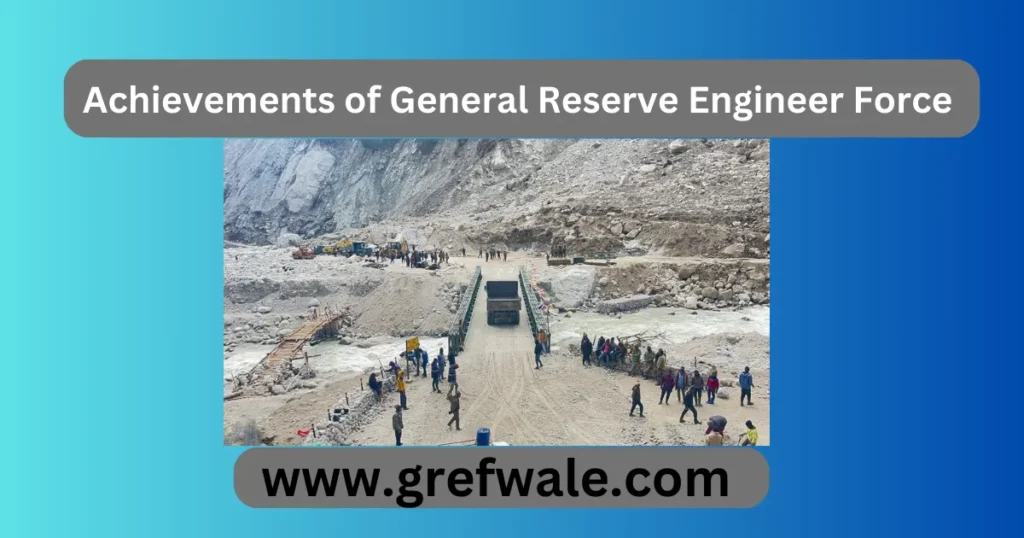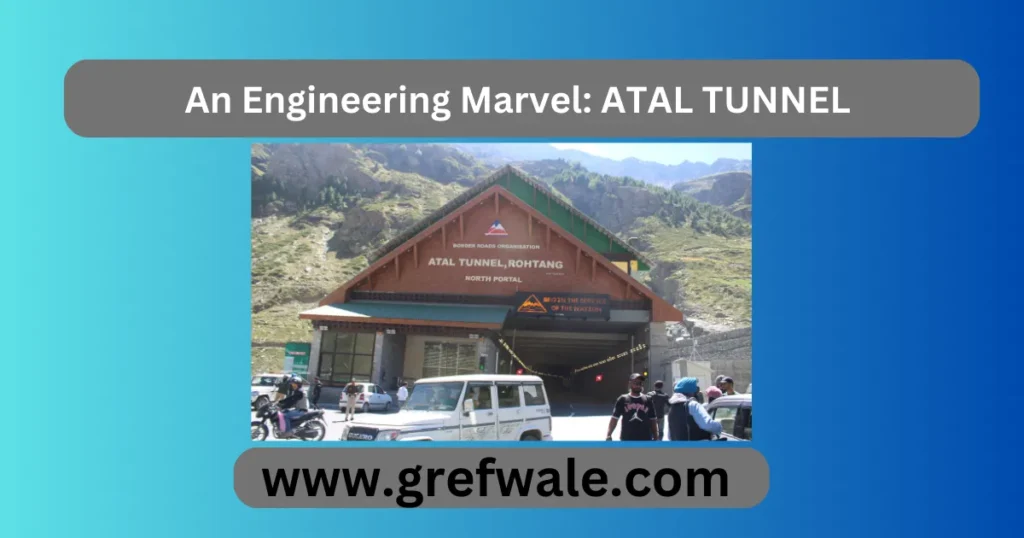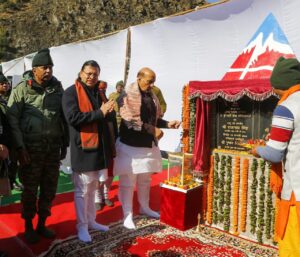About Border Road Organisation:
What is Border Road Organisation ?: Pandit Jawaharlal Nehru established BRO in 1960 with the goal of organizing the quick construction of a road network in the nation’s northern and northeastern border regions.
The Ministry of Defence has administrative control over it. It has become well-liked by the populace and has expanded into a wide range of development and construction projects, including building projects, tunnels, defense projects, and airfields.
Achievements of General Reserve Engineer Force/ Border Road Organisation:

In more than 60 years, the BRO has built 19 airfields, over 900 bridges, over 61,000 km of roads, four tunnels, and hard conditions around India’s borders as well as in friendly neighboring nations including Bhutan, Myanmar, Afghanistan, and Tajikistan.
The BRO finished 103 infrastructure projects in 2022–2023, which was a record for the organization in a single year.
Among them are the building of the Steel Arch Siyom Bridge of Load Class 70 in Arunachal Pradesh on Along-Yinkiong Road and the Shyok Bridge in Eastern Ladakh.
Other Important Task Completed By BRO

In the border regions of India and its friendly bordering countries, BRO builds and maintains road networks. This covers infrastructure operations in adjacent nations like Afghanistan, Bhutan, Myanmar, Tajikistan, and Sri Lanka.
As well as in 19 states and three union territories, which include the Andaman and Nicobar Islands. By 2021, BRO has built more than 450 permanent bridges totaling more than 44,000 meters (27 mi) in length, over 50,000 kilometers (31,000 mi) of highways, and 19 airfields in key areas.
Additionally, BRO is responsible for the upkeep of this infrastructure, which includes tasks like snow removal.
The India-China Border Roads are being greatly upgraded and constructed thanks in large part to BRO. The BRO’s parent cadre consists of officers and staff from the General Reserve Engineer Force (GREF).
In Addition
Additionally, it employs commanders and soldiers on extra regimental employment (via deputation) from the Indian Army’s Corps of Engineers.
The Armed Forces’ Order of Battle includes BRO as well, guaranteeing their assistance at all times. “Shramena Sarvam Sadhyam” is the organization’s motto, which means “everything is achievable through hardwork.”
When Dr. JB Auden of the Geological Survey of India visited the Rohtang Pass in 1942, he had the idea to build a tunnel across it in order to channel water from the Chandra River to the Beas. Later, in a letter to the Indian Prime Minister at the time in June 1983.
Then-chief minister of Himachal Pradesh proposed building a highway tunnel through this route to provide access to Lahaul and Spiti Valley in all weather conditions.
The issue was then looked into in the Prime Minister’s office after consulting with the Ministry of Road, Transport & Highways (formerly the Ministry of Shipping and Transport).
An Engineering Marvel: ATAL TUNNEL: What is Border Road Organisation ?

On the Leh-Manali Highway in Himachal Pradesh, India, the Atal Tunnel, also called the Rohtang Tunnel, is a highway tunnel situated beneath the Rohtang Pass in the eastern Pir Panjal range of the Himalayas.
Named after the former Indian prime minister, Atal Bihari Vajpayee, it is the longest tunnel above 10,000 feet (3,048 m) in the world, measuring 9.02 km. The Rohtang Pass is located at an elevation of 3,978 meters (13,051 feet), whereas the tunnel is located at 3,100 meters (10,171 feet). On October 3, 2020,
Prime Minister Narendra Modi gave it its official opening. The project will set you back ₹3,200 crore in total.
Must Read:
Bharat Series Registration for Old Vehicles-Get Ready for 2024
Key Points Of Atal Tunnel
December 2019: The Atal Tunnel – A Landmark Transformation
In the picturesque region of Himachal Pradesh, a monumental shift occurred in December 2019. The renowned Rohtang Tunnel officially became the Atal Tunnel, named in honor of the former Prime Minister of India,
Atal Bihari Vajpayee. This marked the initial step towards a groundbreaking change that would significantly impact the region and its connectivity.
September 2020: A Triumph of Engineering
Fast forward to September 2020, and the Atal Tunnel project reached its zenith. The completion milestone of 100% brought not just relief but a sense of achievement.
The tunnel, strategically vital for the region, had overcome numerous challenges during its construction, solidifying its status as an engineering marvel.
Oct 2020: Unveiling the Gateway – A Grand Inauguration
The grandeur of the official opening on October 3, 2020, was unparalleled. In the presence of distinguished guests, including Himachal Pradesh’s Chief Minister Jai Ram Thakur.
Minister of State for Finance Anurag Thakur, and Defense Minister Rajnath Singh, Prime Minister Narendra Modi inaugurated the Atal Tunnel.
This event was not merely ceremonial; it symbolized a new era of connectivity and accessibility for the region.
Engineering Marvel: Breaking Down the Atal Tunnel’s Technical Prowess
The Atal Tunnel, stretching over 9 kilometers, is an engineering marvel situated at an altitude of approximately 3,000 meters.
The tunnel is equipped with state-of-the-art technology, ensuring a smooth and secure passage. Overcoming challenges such as unpredictable weather conditions and challenging terrain, the project showcased the resilience and expertise of the engineering team.
Strategic Importance: Beyond Connectivity
Beyond its role in enhancing transportation and connectivity, the Atal Tunnel holds immense strategic importance.
Its proximity to the international border adds a layer of national security, making it not just a conduit for civilians but a vital asset for the armed forces.
The tunnel’s completion also brought economic benefits, boosting trade and tourism in the region.
The Official Inauguration: A Momentous Occasion
The official inauguration, attended by key dignitaries, underscored the significance of the Atal Tunnel. Prime Minister Narendra Modi’s role in the symbolic opening emphasized the government’s commitment to infrastructural development.
The date, October 3, 2020, will be etched in history as the day when the Atal Tunnel opened its gates to the public.
Post-Inauguration Developments: Navigating Success and Challenges
The public response to the Atal Tunnel was overwhelming. It not only reduced travel time but also opened up new opportunities for economic growth.
Operational improvements were continually implemented, taking into account the lessons learned during the initial phases of usage. The Atal Tunnel became more than a passageway; it became a symbol of progress and development.
Atal Tunnel in the News: Making Headlines Globally
Media coverage of the Atal Tunnel was extensive, with international recognition and numerous awards following suit. The tunnel became a benchmark for other infrastructure projects globally.
Its impact resonated not just nationally but internationally, showcasing India’s prowess in executing complex engineering projects.
Impact on Himachal Pradesh: From Transformation to Prosperity
The Atal Tunnel brought about significant socio-economic changes in Himachal Pradesh. Infrastructure growth, increased employment opportunities, and a surge in tourism painted a picture of prosperity for the region.
Local perspectives on the Atal Tunnel varied but were collectively aligned in acknowledging its transformative impact.
Environmental Considerations: Balancing Progress with Conservation
Amidst the celebration of progress, the Atal Tunnel project was mindful of environmental considerations.
Conservation measures during construction, ongoing monitoring, and sustainable practices in tunnel management reflected a commitment to preserving the natural beauty of the region.
The Atal Tunnel Experience: A Journey Beyond Infrastructure
Traveler testimonials highlighted not only the safety measures and regulations in place but also the scenic beauty and attractions along the route.
The Atal Tunnel became an experience, transcending its primary function and offering a unique blend of adventure and awe-inspiring landscapes.
Challenges and Solutions: Lessons From the Atal Tunnel Project
The journey of the Atal Tunnel was not without challenges. Unforeseen obstacles during construction required adaptive strategies.
These challenges provided valuable lessons for future infrastructure projects, emphasizing the importance of resilience and flexibility.
International Comparison: Benchmarking Excellence
Benchmarking the Atal Tunnel with similar tunnels worldwide showcased its unique features and set new standards in tunnel engineering.
The tunnel stood out for its elevation, length, and the challenges overcome during construction.
Future Prospects: Building on Success
Looking ahead, the Atal Tunnel holds promising prospects. Potential expansions and developments are on the horizon, ensuring long-term benefits for the region. The sustainability initiatives employed in the project serve as a blueprint for future infrastructural endeavors.
Atal Tunnel Temperature
Temperature variation in the area: 25–30 °C (77–86 °F) during May–June, −30 to −20 °C (−22 to −4 °F) during Dec–Jan.
May-June: Balmy Warmth and Sunny Days
As spring transitions into summer, the temperature in the Atal Tunnel area experiences a notable rise, ranging from a comfortable 25 to 30 degrees Celsius (77 to 86 degrees Fahrenheit).
During these months, the region is bathed in balmy warmth, with the sun casting its golden glow over the picturesque landscapes.
This period is marked by clear skies and pleasant conditions, making it an ideal time for outdoor activities and travel.
December-January: Embracing the Winter Chill
Contrastingly, the winter months of December and January bring about a dramatic shift in the temperature dynamics. The mercury plunges to a bone-chilling -30 to -20 degrees Celsius (-22 to -4 degrees Fahrenheit).
Creating a frosty landscape reminiscent of a winter wonderland. The cold during this period is relentless, with snow-covered terrain and icy winds dominating the scene.
Watch This Video and Know More About GREF
The Border Road Organization: What is it ?
Support for road development is given to the Indian Armed Forces via the Border Roads Organisation (BRO), an executive body.
In the border regions of India and its friendly bordering countries, BRO builds and maintains road networks.
Under what ministry does border road fall ?
The Defence Ministry is responsible for carrying out a wide range of tasks, some of which are critical Border Roads Infrastructure and include border control, internal security, administration of Union Territories and disaster management.
Who is the BRO DGBR ?
The 28th director general (DG) of the Border Roads Organization (BRO), Lieutenant General Raghu Srinivasan, took over Organisation.
According to the Defence Ministry, his promotion to the BRO’s highest position comes after Lt Gen Rajeev Chaudhry’s superannuation.
What is the BRO motto ?
Shramena Sarvam Sadhyam is the organization’s motto, which means “everything is achievable through hardwork.”
What are the three features of border roads ?
These are state-border-adjacent roads. These are roads constructed in the border region for national security.
These are the routes that are meant to link different communities. There are highways that link the state capital with various district offices.
What is GREF/BRO salary?
The General Reserve Engineer Force (GREF) will pay BRO Multi Skilled Workers a Basic Pay ranging from INR 18000 to INR 56900 per month.
Does BRO have formal authority ?
The Ministry of Defence, Government of India, is the legal owner of the Border Roads Organisation (BRO). In the border regions of India and its friendly bordering countries, BRO builds and maintains road networks.




